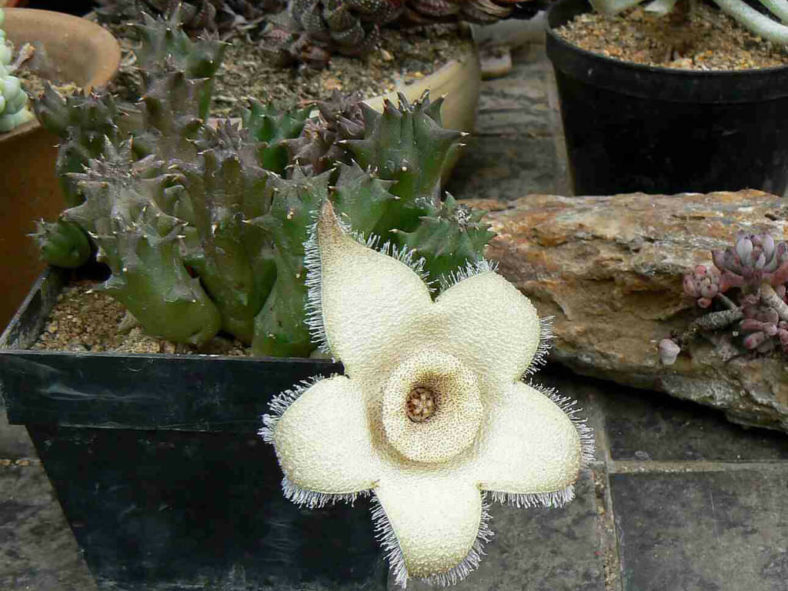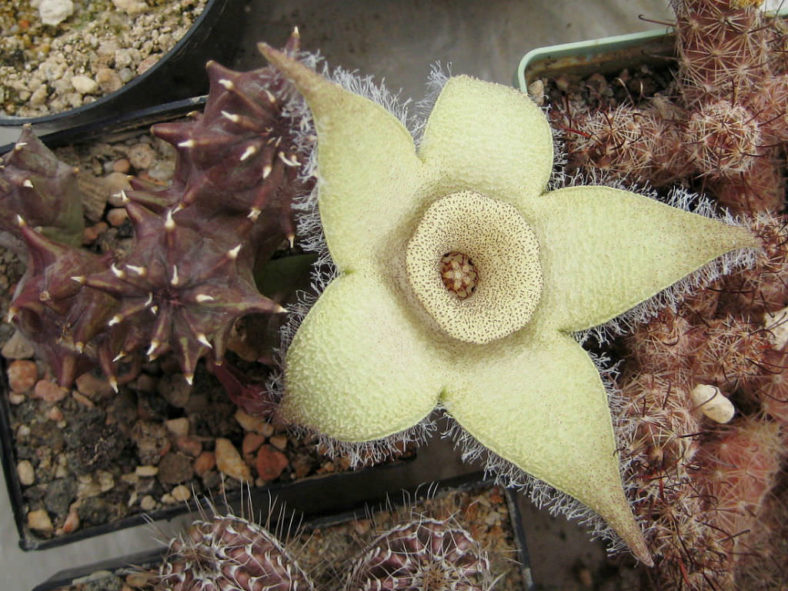Scientific Name
Orbea ciliata (Thunb.) L. C. Leach
Common Name(s)
Starfish Stapelia, Near-white Starfish, Double Crown, Double Cup
Synonym(s)
Stapelia ciliata, Diplocyatha ciliata, Stisseria ciliata
Scientific Classification
Family: Apocynaceae
Subfamily: Asclepiadoideae
Tribe: Ceropegieae
Subtribe: Stapeliinae
Genus: Orbea
Etymology
The specific epithet "ciliata" (pronounced "sil-ee-ATE-uh") means "having cilia" and refers to the cilia along the margins of the lobes of the corolla of this species.
Origin
Orbea ciliata is native to South Africa (Cape Province).
Description
Orbea ciliata is a mat-forming succulent with green, decumbent or ascending stems beautifully marked with purple-brown to nearly entirely purple-brown if grown in full sun. The stems are stout, often nearly cylindrical, with prominent conical tubercles that taper into a fine, acute tip. They can measure up to 4.8 inches (12 cm) long and 1 inch (2.5 cm) in diameter, excluding teeth.
The flowers are star-shaped with white vibratile cilia along the margins of the lobes. They can reach a diameter of up to 4.4 inches (11 cm). The inside of the flower, including the annulus, is cream to pale greenish-yellow and covered with a fairly dense patchwork of irregular, short ridges usually tipped with purple-red. The outside is smooth, pale green, dotted and streaked with reddish-purple, usually with five slightly raised, darker veins along lobes.

Hardiness
USDA hardiness zone 9a to 11b: from 20°F (-6.7°C) to 50°F (10°C).
How to Grow and Care
Several species are fairly easy to grow. Others, often those with slightly hairy stems and the more unusual flowers, are more challenging and require careful watering (with some fertilizer) during the growing season and complete water withdrawal during the winter months. A minimum winter temperature of 10°C (50°F) is acceptable if the soil is kept dry. A heated growing bench or incubator may help delicate plants get through the colder months. However, many species live under shrubs in their habitat and prefer light shade rather than full sun.
A gritty compost is essential, and clay pots are advisable for the more delicate species. Some growers prefer mineral-only compost to minimize the chance of a fungal attack on the roots.
Keeping Stapelias and their roots free of pests such as mealybugs is the key to success, as fungal attack often occurs due to insect damage to stems.
See more at How to Grow and Care for Stapelia.
Links
- Back to genus Orbea
- Succupedia: Browse succulents by Scientific Name, Common Name, Genus, Family, USDA Hardiness Zone, Origin, or cacti by Genus
Photo Gallery
Click on a photo to see a larger version.


